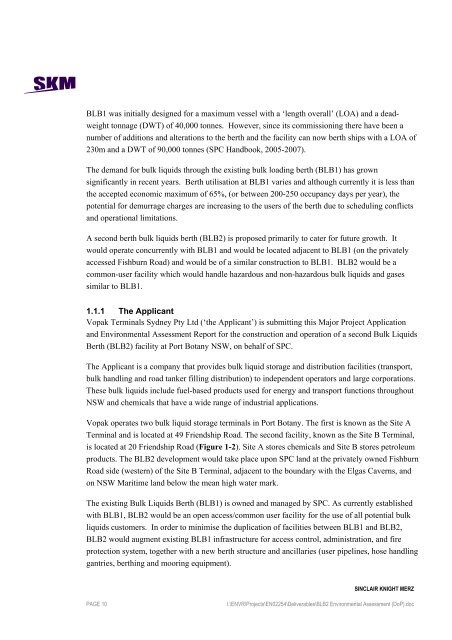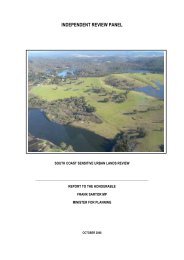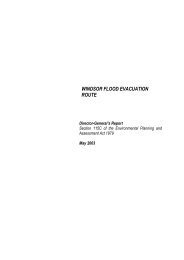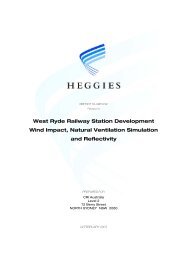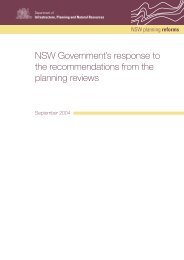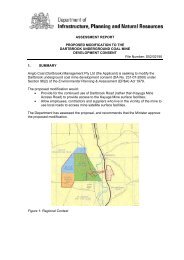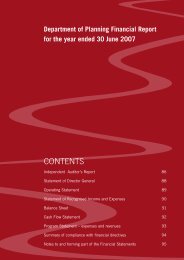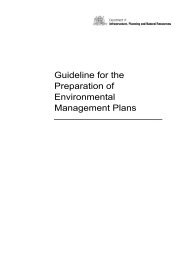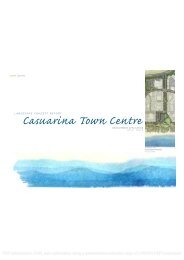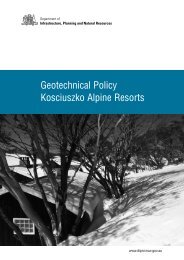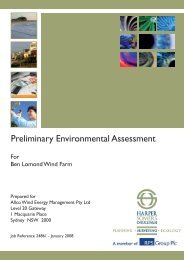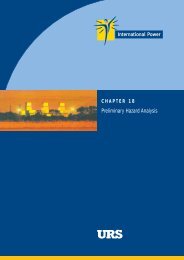Bulk Liquids Berth No. 2 - Port Botany - Department of Planning ...
Bulk Liquids Berth No. 2 - Port Botany - Department of Planning ...
Bulk Liquids Berth No. 2 - Port Botany - Department of Planning ...
You also want an ePaper? Increase the reach of your titles
YUMPU automatically turns print PDFs into web optimized ePapers that Google loves.
BLB1 was initially designed for a maximum vessel with a ‘length overall’ (LOA) and a deadweight<br />
tonnage (DWT) <strong>of</strong> 40,000 tonnes. However, since its commissioning there have been a<br />
number <strong>of</strong> additions and alterations to the berth and the facility can now berth ships with a LOA <strong>of</strong><br />
230m and a DWT <strong>of</strong> 90,000 tonnes (SPC Handbook, 2005-2007).<br />
The demand for bulk liquids through the existing bulk loading berth (BLB1) has grown<br />
significantly in recent years. <strong>Berth</strong> utilisation at BLB1 varies and although currently it is less than<br />
the accepted economic maximum <strong>of</strong> 65%, (or between 200-250 occupancy days per year), the<br />
potential for demurrage charges are increasing to the users <strong>of</strong> the berth due to scheduling conflicts<br />
and operational limitations.<br />
A second berth bulk liquids berth (BLB2) is proposed primarily to cater for future growth. It<br />
would operate concurrently with BLB1 and would be located adjacent to BLB1 (on the privately<br />
accessed Fishburn Road) and would be <strong>of</strong> a similar construction to BLB1. BLB2 would be a<br />
common-user facility which would handle hazardous and non-hazardous bulk liquids and gases<br />
similar to BLB1.<br />
1.1.1 The Applicant<br />
Vopak Terminals Sydney Pty Ltd (‘the Applicant’) is submitting this Major Project Application<br />
and Environmental Assessment Report for the construction and operation <strong>of</strong> a second <strong>Bulk</strong> <strong>Liquids</strong><br />
<strong>Berth</strong> (BLB2) facility at <strong>Port</strong> <strong>Botany</strong> NSW, on behalf <strong>of</strong> SPC.<br />
The Applicant is a company that provides bulk liquid storage and distribution facilities (transport,<br />
bulk handling and road tanker filling distribution) to independent operators and large corporations.<br />
These bulk liquids include fuel-based products used for energy and transport functions throughout<br />
NSW and chemicals that have a wide range <strong>of</strong> industrial applications.<br />
Vopak operates two bulk liquid storage terminals in <strong>Port</strong> <strong>Botany</strong>. The first is known as the Site A<br />
Terminal and is located at 49 Friendship Road. The second facility, known as the Site B Terminal,<br />
is located at 20 Friendship Road (Figure 1-2). Site A stores chemicals and Site B stores petroleum<br />
products. The BLB2 development would take place upon SPC land at the privately owned Fishburn<br />
Road side (western) <strong>of</strong> the Site B Terminal, adjacent to the boundary with the Elgas Caverns, and<br />
on NSW Maritime land below the mean high water mark.<br />
The existing <strong>Bulk</strong> <strong>Liquids</strong> <strong>Berth</strong> (BLB1) is owned and managed by SPC. As currently established<br />
with BLB1, BLB2 would be an open access/common user facility for the use <strong>of</strong> all potential bulk<br />
liquids customers. In order to minimise the duplication <strong>of</strong> facilities between BLB1 and BLB2,<br />
BLB2 would augment existing BLB1 infrastructure for access control, administration, and fire<br />
protection system, together with a new berth structure and ancillaries (user pipelines, hose handling<br />
gantries, berthing and mooring equipment).<br />
SINCLAIR KNIGHT MERZ<br />
PAGE 10<br />
I:\ENVR\Projects\EN02254\Deliverables\BLB2 Environmental Assessment (DoP).doc


